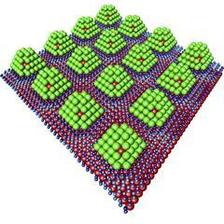The KFS (Committee Research with Synchrotron radiation, in German: 'Komitee für Synchrotronstrahluing') is an elected representative of the more than 4000 users of synchrotron radiation sources in Germany and at international institutions with German participation. (Credit: KFS)
Synchrotron radiation shows us how materials are built up and how they work - also materials that we need to become less dependent on fossil fuels, for example in solar cells, in batteries and in the production of green hydrogen.
What influences the climate and how can we counteract climate change and cope with the consequences? Society must deal with these three central problems of climate change (physical science basis, mitigation, adaptation according to the IPCC), and research with synchrotron radiation makes a valuable contribution to this. The focus is on research into materials that make us independent of fossil energy - for example materials for solar collectors, batteries, the production of green hydrogen and in the conversion of CO2. Beyond that, the diverse synchrotron radiation methods are also used to understand the Earth system and the climate. The research infrastructure required for this is funded by the Federal Ministry of Education and Research in current BMBF programmes such as "Exploring the Universe and Matter ErUM" (ErUM-Pro and ErUM-Data).
Synchrotron radiation is extremely intense radiation up to the X-ray range. It is generated at large-scale research facilities such as storage rings or free-electron lasers in which charged particles accelerated to almost the speed of light emit photons, an intense light that is called synchrotron radiation. In Germany, there are the synchrotron radiation sources PETRA III and FLASH at the DESY, BESSY II at the Helmholtz-Zentrum Berlin (HZB), the European XFEL in Schenefeld near Hamburg, with German participation the ESRF in Grenoble (France), the KIT light source in Karlsruhe and DELTA in Dortmund.
To tackle climate change, we need to save energy - both through our behaviour and through greater energy efficiency. In addition, we must make greater use of renewable energy, the generation and storage of which are based on technological solutions. To do this, we use materials whose special properties remain hidden to the naked eye. How semiconductors convert solar energy into electricity, how batteries store electrical charge or how catalysts help to efficiently convert CO2 or produce hydrogen becomes clear when studied with synchrotron radiation. Of course, these materials are also studied with other methods, but certain information can be obtained more easily or quickly, while other, crucial information can only be obtained at the synchrotron.
Research on the fundamental properties of matter with synchrotron radiation is a fascinating, multifaceted field of research to which an active, international and interdisciplinary research area is dedicated. Principles of physics, chemistry, crystallography and biology are applied and interconnected here, and the further development of methods enables ever deeper insights. Researchers from other fields also like to use synchrotron radiation for their questions and draw on the available expertise for this purpose. Therefore, research with synchrotron radiation is thematically broad, which is also reflected in climate-relevant research. Basic research and technological developments are closely linked through research associations and cooperation platforms.
"Today, the chemical industry still uses almost entirely fossil raw materials for the production of chemical products. Converting this to renewable ones is a major challenge. Synchrotron radiation is a unique key to this because it allows us to observe how the catalysts needed for this work - "operando" in technical jargon. Only in this way can materials be developed in a targeted and efficient way and create a basis for computer-aided design," says Prof. Jan-Dierk Grunwaldt, KFS chairman and himself involved in the conversion of wind and solar energy or biomass into chemical products.
Partly from: KFS Press Release (3 May 2022)







